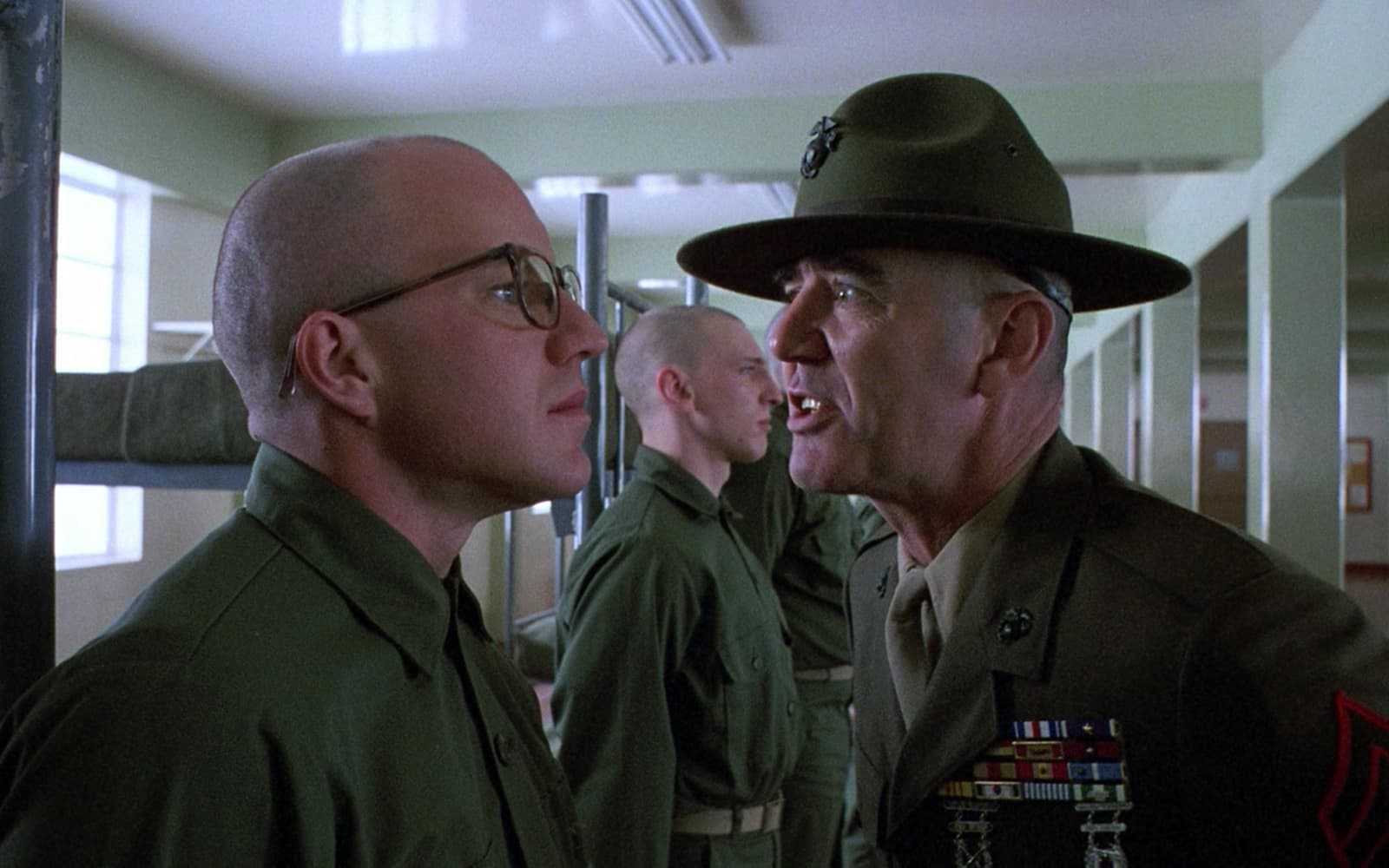Full Metal Jacket by Stanley Kubrick (Review)

I’ve talked to friends who consider Hannibal Lector to be the scariest character ever depicted in a movie. For my money, however, I can think of no scarier character than Gunnery Seargant Hartman — if Lector ever encountered Hartman in all of his eye-gouging and skull-f*cking glory, I doubt that even Lector would remain unfazed. It’s primarily because Hartman’s character that Full Metal Jacket is the first film that leaps to my mind when someone mentions Stanley Kubrick. Perhaps it doesn’t have the technological foresight of 2001, the wintry, atmospheric terror of The Shining, or even as much social commentary as A Clockwork Orange, but I really can’t think of a Kubrick film that so completely displays Kubrick’s common themes of dehumanization and alienation as Full Metal Jacket.
The movie revolves around the character of Private Joker (Modine), a carefree smart-aleck that, as the film progresses, slowly devolves into a sort of nihilistic clown. But to call him the “main character” is probably a mistake. Calling someone the “main character” or “protagonist” implies that it’s possible to make a connection with them, that there’s something about them that we, as fellow humans, can relate to. However, as the movie progresses, the characters in Full Metal Jacket seem less and less human. At times, they seem to be merely bodies inhabited with apathetic spirits, men who have become completely empty and hollow by the abuse and violence that they have seen and done.
Full Metal Jacket feels like two different movies, or one movie with two very distinct acts. The first act follows Joker and a bunch of other raw recruits as they are broken and reassembled as Marines by Hartman. I have to admit a certain admiration for Hartman, because I have never heard epithets, threats, and obscenities hurled with such force and creativity. According to the Internet Movie Database, Kubrick was inspired to use Ermey (a former drill instructor) after watching a tape of him yelling obscenities for 15 minutes while being pummelled with oranges — without repeating himself. I think Daily Radar, in their list of the top 200 events in entertainment history, hit the nail on the head when they said that Ermey was the “acting equivalent of full-grain alcohol.”
This part of the film eventually ends in disaster after one of the recruits, Private Pyle, snaps under the pressure of Hartman’s abuse. Pyle bears the brunt of Hartman’s insults throughout the movie, as Hartman tries to toughen and straighten out Pyle. It’s a course of action with disastrous consequences.
Primarily because of Hartman’s performance, the second act often feels overshadowed, or weaker than the first. Joker is now in Vietnam as a combat journalist. He hooks up with an old friend and tags along with his unit throughout the rest of the movie. But after watching this part several times, I’ve come to realize that’s not the case.
We now see the effects of the training and the hellish fighting that these men have been forced to endure. They’ve become the killers that they were trained to be. Now, all they care about is living longer than the guy trying to kill them. High-minded ideas of democracy and freedom are now alien concepts. For them, to simply live from one day to the next is enough; as Joker puts it, “the dead know only one thing: it is better to be alive.” It’s a far cry from the sort of immortality promised to them by Hartman: “Marines die, that’s what we’re here for. But the Corps lives forever, and that means you live forever.”
As with all of Kubrick’s films, Full Metal Jacket is full of striking scenes. While visually interesting, it also creates a detached feel throughout much of the film. When soldiers are hit by sniper fire, their agony is caught in slow-motion, making it so painful to watch as to be surreal. The boot camp’s barracks are painted in shades of blue at night, long tracking shots follow the soldiers as they march down the road, and the final shot of soldiers marching against a hellish backdrop of burning rubble while singing the Mickey Mouse Club theme are all etched into my mind. And Kubrick’s use of ominous music is incredible, especially during the film’s dramatic high points; it underscores the tension and turmoil that hides just beneath the surface of such scenes.
I often describe this film as disturbing, but not for the normal reasons. There is certainly graphic violence and language. Kubrick does not shy away from such material in any way. Instead, he captures and frames it so that we can’t help but see and dissect it. But this isn’t why I consider this film disturbing. I consider it disturbing because, by the film’s end, I realize I have no connection to the characters at all. Instead, I find myself watching men that are no longer human.
The film is not a blatant anti-war statement, but rather, a question about how these men are able to make it through each day while seeing and committing terrible atrocities, a question about how their training and their actions will influence them years later. At times, I wonder what a homecoming would be like for these men, what would their integration back into “normal” civilian life be like? In the movie, they seem so far removed from normal human intimacy and decency. It’s this question, and not anything that gave this film an “R” rating, that makes Full Metal Jacket so disturbing, captivating, and memorable.
